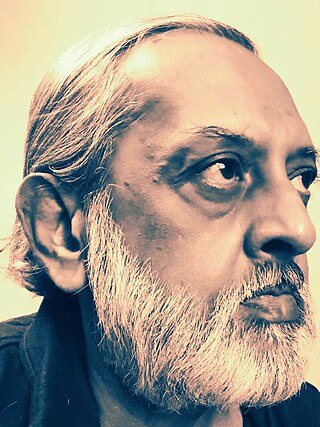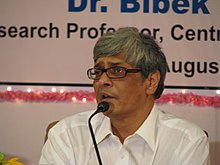
The Mahābhārata is one of the two major Smriti texts and Sanskrit epics of ancient India revered in Hinduism, the other being the Rāmāyaṇa. It narrates the events and aftermath of the Kurukshetra War, a war of succession between two groups of princely cousins, the Kauravas and the Pāṇḍavas.

Parashurama, also referred to as Rama Jamadagnya, Rama Bhargava and Virarama, is the sixth avatar among the Dashavatara of the preserver god Vishnu in Hinduism. He is believed to be one of the Chiranjivis (Immortals), who will appear at the end of the Kali Yuga to be the guru of Vishnu's tenth and last incarnation, Kalki.

Krishna Dvaipayana, better known as Vyasa or Veda Vyasa, is a revered rishi (sage) portrayed in most Hindu traditions. He is traditionally regarded as the author of the epic Mahābhārata.
In Hinduism, Itihasa-Purana, also called the fifth Veda, refers to the traditional accounts of cosmogeny, myths, royal genealogies of the lunar dynasty and solar dynasty, and legendary past events, as narrated in the Itahasa and the Puranas. They are highly influential in Indian culture, and many classical Indian poets derive the plots of their poetry and drama from the Itihasa. The Epic-Puranic chronology derived from the Itihasa-Puranais an influential frame of reference in traditional Indian thought.

Narayana is one of the forms and epithets of Vishnu. In this form, the deity is depicted in yogic slumber under the celestial waters, symbolising the masculine principle and associated with his role of creation. He is also known as Purushottama, and is considered the Supreme Being in Vaishnavism.

Sarathi is an epithet of the Hindu deity Krishna used in the epic Mahabharata. It is also a common personal name in South India.

Ashtavakra is a revered Vedic sage in Hinduism. His maternal grandfather was the Vedic sage Aruni, his parents were both Vedic students at Aruni's school. Ashtavakra studied, became a sage and a celebrated character of the Hindu Itihasa epics and Puranas.

The Harivamsa is an important work of Sanskrit literature, containing 16,374 shlokas, mostly in the anustubh metre. The text is also known as the Harivamsa Purana. This text is believed to be a khila to the Mahabharata and is traditionally ascribed to Vyasa. The most celebrated commentary of the Mahabharata by Neelakantha Chaturdhara, the Bharata Bhava Deepa also covers the Harivamsa. According to a traditional version of the Mahabharata, the Harivamsa is divided into two parvas (books) and 12,000 verses. These are included with the eighteen parvas of the Mahabharata. The Critical Edition has three parvas and 5,965 verses.

Yama, also known as Kāla and Dharmarāja, is the Hindu god of death and justice, responsible for the dispensation of law and punishment of sinners in his abode, Naraka. He is often identified with Dharmadeva, the personification of Dharma, though the two deities have different origins and myths.

Vaishampayana is the traditional narrator of the Mahabharata, one of the two major Sanskrit epics of India.
An astra is a supernatural weapon in Hindu mythology. It is presided over by a specific deity and imbued with spiritual and occult powers that causes its effects.The term came to subsequently denote any weapon which was used by releasing it from one's hand, compared to keeping it one's hand.

Devdutt Pattanaik is a mythologist and writer from Mumbai, India. He writes on mythology, the study of cultural truths revealed through stories, symbols and rituals. He lectures on the relevance of both Indian and Western myths in modern life. His work focuses largely on the areas of religion, mythology, and management. He has authored and illustrated over 50 books, including ABC Of Hinduism, Bahubali : 63 insights into Jainism, and Yoga Mythology: 64 Asanas and Their Stories.
The Shalya Parva, or the Book of Shalya, is the ninth of eighteen books of the Indian epic Mahabharata. Shalya Parva traditionally has 4 parts and 65 chapters. The critical edition of Shalya Parva has 4 parts and 64 chapters.

Panchajanya is the shankha (conch) of the Hindu preserver deity Vishnu, one of his four primary attributes. The Panchajanya symbolises the five elements, and is considered to produce the primeval sound of creation when blown.

Ashvamedhika Parva, is the fourteenth of eighteen books of the Indian epic Mahabharata. It traditionally has 2 parts and 96 chapters. The critical edition has one sub-book and 92 chapters.
Svargarohana Parva or the Book of the Ascent to Heaven, is the last of eighteen books of the Indian epic Mahabharata. It traditionally has 6 chapters. The critical edition has 5 chapters. It is one of the shortest books in the Mahabharata.
Brihadbala is a king featured in Hinduism. He is a character in the Hindu epic Mahabharata. He is described to be the last king of the Kosala Kingdom. In the Kurukshetra War, Brihadbala fought for the Kauravas and was killed by Abhimanyu.

Ramakrishna Ramesh Menon is an Indian author of several literary renderings in modern English prose of classical works from the ancient Hindu tradition.
A phalashruti is a meritorious verse in Hindu literature, appearing at the end of a text or one of its constituent sections. Such a verse offers a description of the benefits that could be accrued by an adherent from the recitation or listening to a given text. It may also extol the prominence of a work, as well as provide the appropriate context for its perusal.













